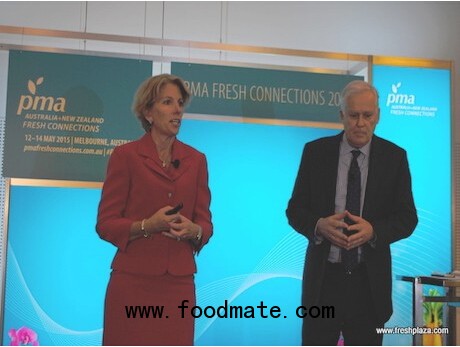
The audience was told that by 2050 food production must increase by 70%, and 70% of the population will live in urban areas. “This comes at a time when natural resources are scarce. Farm land, farm labour, water. All of these are being challenged,” said Ms Burns. She reminded the audience that ‘cutting’ their budgets to reach prosperity was not the answer, but that there were choices growers can make with the help of PMA to improve efficiencies, and effectiveness to better position themselves, brands and organisations. “Opportunities are there. They exist to make the system more efficient, more accurate and certainly more safe.” Some of those examples include wearable cameras and drones, already being used in farms across the world. Knowing what a positive sample means, and more importantly what it doesn’t mean, will become easier as the science is better understood, according to Ms Burns.
Ways of repurposing real estate or using greenhouses closer to urban areas, and using technology to detect issues in crops were also highlighted as areas where there is a lot of ongoing activity. The example of the Sony building in Japan that is now a greenhouse following the 2011 tsunami there was also offered.
Real time information, price accuracy and integrity and problems solved immediately. That is what Ms Burns told the audience consumers want when it comes to fresh produce. This places pressure in infrastructure and traditional methods, leading many to turn to social media. With respect to social media that message was that “It’s a cheap way to market, but you need to be really responsible when consumers are talking about you and your brands.” Data was ‘great’ but people needed to know what to do with it, Ms Burns said. “The data is gold if you’re willing to change your behaviours and really look at your marketing strategies in order to leverage that.”
DIY customers and social media – key new trends
Ms Burns shared the fact that the number one reason consumers use social media is for searches and information related to food, and discussed the ‘DIY’ trend among consumers wanting to do their own thing, in their own way, at their own pace and at the right price. The population growth indicated by 2050 will also mean a much larger middle class. It is expected to grow to 4.9 billion people by 2050, and those people have higher disposable incomes and a focus on nutrition, affordability and freshness, the audience heard.
Multiculturalism, transparency and the importance of word of mouth marketing, convenience serving single member households, and the online community of 2.3 billion online shoppers around the world were the key consumer trends mentioned. Optimising websites for mobile was listed as the number one priority for more than 60% of CEO’s surveyed, the audience heard. That makes sense with some 81% of smartphone users saying that they have used technology to improve their health.
“Customers do want to know what’s in their food. How it’s grown? How are you giving back to the community?,” Ms Burns told the audience. “What is your story for 2015 - how are you telling it? Across what mediums? What platforms?”
Use the PMA – message to growers
When it comes to dealing with outbreaks or even questions about global situations the message to the industry was to lean on PMA as a source of information and answers. “Take advantage of the opportunity of the rich research that’s out there and take advantage of the fact there’s someone to talk to,” she said. The PMA exists as an association to represent the industry in a way that ‘no single company can’ she added. “We end up being the voice for all of you.”
Ms Burns was accompanied on the stage by PMA A-NZ CEO Michael Worthington. The launch and conference were ahead of a separate trade show day on Wednesday and seminars on Thursday, May 14, before the end of the three day Fresh Connections event. Next year's event is likely to be held in Sydney.





